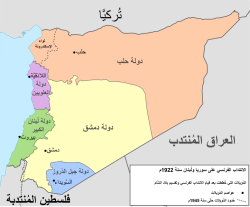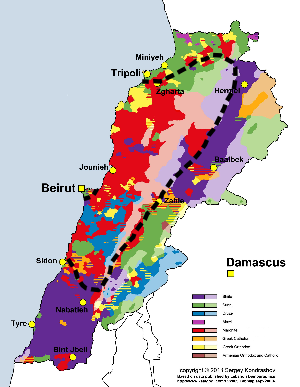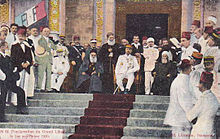大黎巴嫩國
外觀
此條目目前正依照英語和法語版本上的內容進行翻譯。 (2024年12月27日) |
| 1920年—1943年 | |||||||||
 敘利亞及黎巴嫩託管地,綠色為大黎巴嫩 | |||||||||
| 地位 | 法國保護國下的自治國家 | ||||||||
| 首都 | 貝魯特 | ||||||||
| 常用語言 | 阿拉伯語、法語、英語、亞美尼亞語 | ||||||||
| 宗教 | 伊斯蘭教、基督教 | ||||||||
| 政府 | 聯邦下的半獨立共和國 | ||||||||
| 歷史時期 | 戰間期與第二次世界大戰 | ||||||||
• 建立 | 1920年 | ||||||||
• 終結 | 1943年 | ||||||||
| 貨幣 | 黎巴嫩-敘利亞鎊 | ||||||||
| |||||||||
大黎巴嫩國(法語:État du Grand Liban)又譯大黎巴嫩州或大黎巴嫩邦(英語:State of Greater Lebanon)通稱大黎巴嫩(阿拉伯語:دولة لبنان الكبير),是於1920年至1926年間,屬於法屬敘利亞及黎巴嫩託管地下的一個自治國家,1926年脫離敘利亞聯邦改隸為黎巴嫩共和國(阿拉伯語:الجمهورية اللبنانية)。
背景
[編輯]起源
[編輯]
在1861年,歐洲國家與鄂圖曼帝國談判通過自然規管協議[暫譯],同意在帝國的地方成立黎巴嫩山穆塔薩勒夫領,來保護當地的基督徒人口。到一次大戰過後,該穆塔薩勒夫領與其他周邊分區合併,成為大黎巴嫩國,面積多了大概一倍。
詞源
[編輯]「大黎巴嫩」(法語:Le Grand Liban)首先由黎巴嫩學者 Bulus Nujaym 和 Albert Naccache 在1919年巴黎和會期間提出[1]。
Nujaym 曾經在1908年出版了很受歡迎的書本《La question du Liban》(黎巴嫩問題),該書的550頁中提出了成立大黎巴嫩國的理由,認為擴大版圖是對黎巴嫩的經濟穩定有必要[2]。
巴黎和會
[編輯]
在巴黎和會期間,黎巴嫩由馬龍尼的牧首 Elias Peter Hoayek 代表,他在1919年10月27日和會裏提出了建議,希望擴大黎巴嫩山穆塔薩勒夫領的範圍。雖然這些地區並非主要由基督徒聚居,但他仍認為這些地方是黎巴嫩的自然一部分[3]。該提議有部分是基於穆塔薩勒夫領有一半人口因黎巴嫩山大饑荒而喪失,而當地教會希望擴大的版圖能夠更有效地為居民提供食糧[4]。擴大的地區包含了的黎波里、貝魯特、賽達、和推羅這幾個大城市,和他們的周邊地區[3]。
參見
[編輯]參考文獻
[編輯]- ^ Marwan R. Buheiry. Bulus Nujaym and the Grand Liban Ideal, 1908–1919. Intellectual Life in the Arab East, 1890 to 1930. Syracuse University Press. 1 June 1981: 63. ISBN 978-0-8156-6086-6.
This article, bearing the dateline of Jounieh, July 10, 1919, constitutes, together with Albert Naccache’s "Notre avenir économique published also in La Revue Phénicienne (July 1919), perhaps some of the earliest written and public references to a Grand Liban. For instance, the term does not appear to have been used seven months earlier by the first Lebanese delegation to Paris - at least not in its official releases. Or to cite a later example, the term was not used in the important correspondence from Clemenceau to Maronite Patriarch Huwayik dated 10 November 1919
- ^ Meir Zamir. The formation of modern Lebanon
 . Cornell University Press. 1988: 15–16. ISBN 978-0-8014-9523-6.
. Cornell University Press. 1988: 15–16. ISBN 978-0-8014-9523-6. Nujaym’s formulation was to become the basis for Lebanese Christian arguments in favor of a Greater Lebanon. It stressed the national rather than economic aspects of that goal. Only extended boundaries would enable Lebanon to exist as an independent state. Nujaym told the European public that the Lebanese question required a definite solution: the establishment of an independent Christian state.
- ^ 3.0 3.1 Salibi 1990,第26頁: "Since the turn of the century, however, the Maronites had pressed for the extension of this small Lebanese territory to what they argued were its natural and historical boundaries: it would then include the coastal towns of Tripoli, Beirut, Sidon and Tyre and their respective hinterlands, which belonged to the Vilayet of Beirut; and the fertile valley of the Bekaa (the four Kazas, or administrtative districts, of Baalbek, the Bekaa, Rashayya and Hasbayya), which belonged to the Vilayet of Damascus. According to the Maronite argument, this 'Greater Lebanon' had always had a special social and historical character, different from that of its surroundings, which made it necessary and indeed imperative for France to help establish it as an independent state. While France had strong sympathies for the Maronites, the French government did not support their demands without reserve. In Mount Lebanon, the Maronites had formed a clear majority of the population. In a 'Greater Lebanon', they were bound to be outnumbered by the Muslims of the coastal towns and their hinterlands, and by those of the Bekaa valley; and all the Christian communities together, in a 'Greater Lebanon', could at best amount to a bare majority. The Maronites, however, were insistent in their demands. Their secular and clerical leaders had pressed for them during the war years among the Allied powers, not excluding the United States."
- ^ Harris 2012, pp. 173–174


